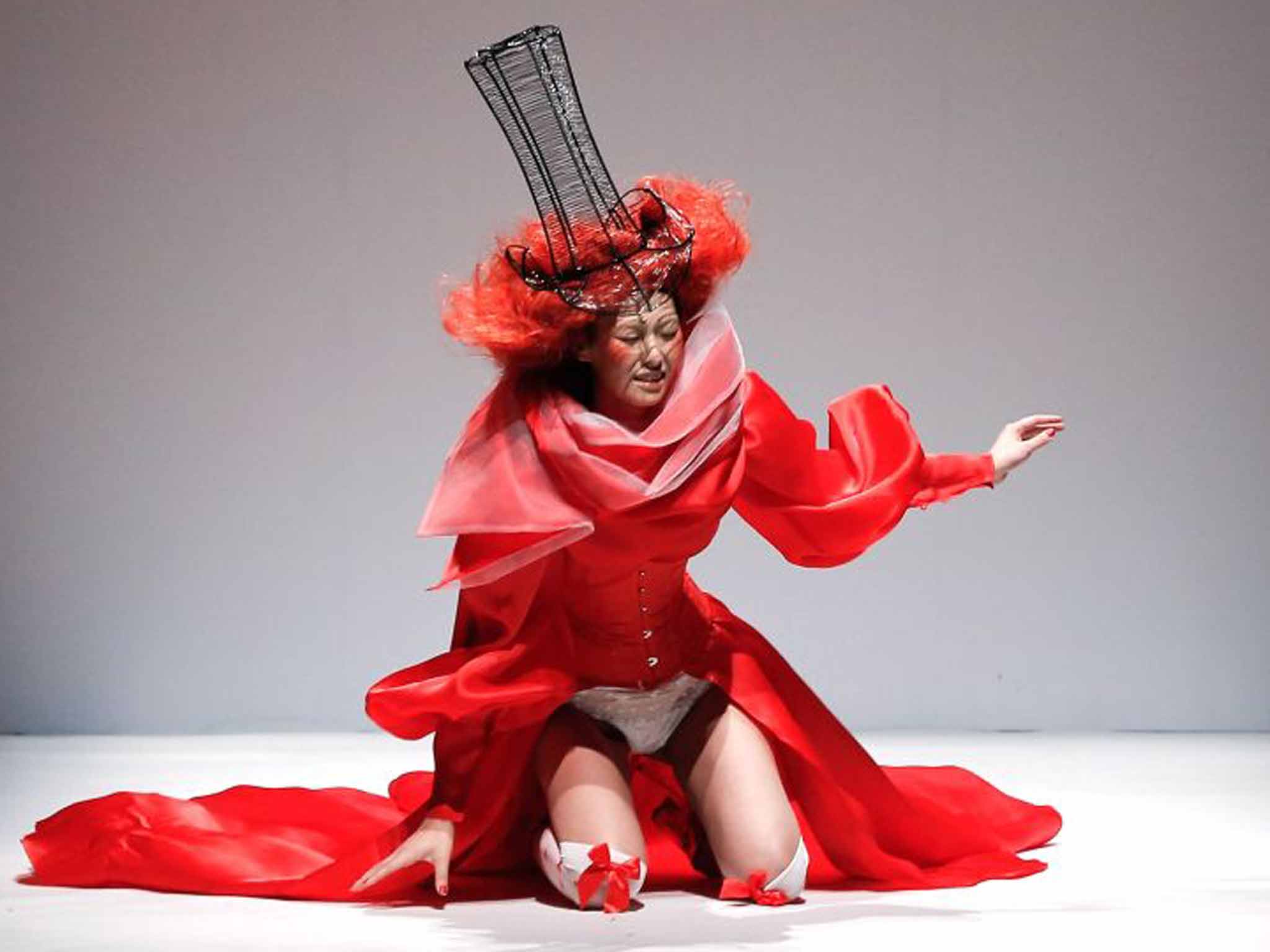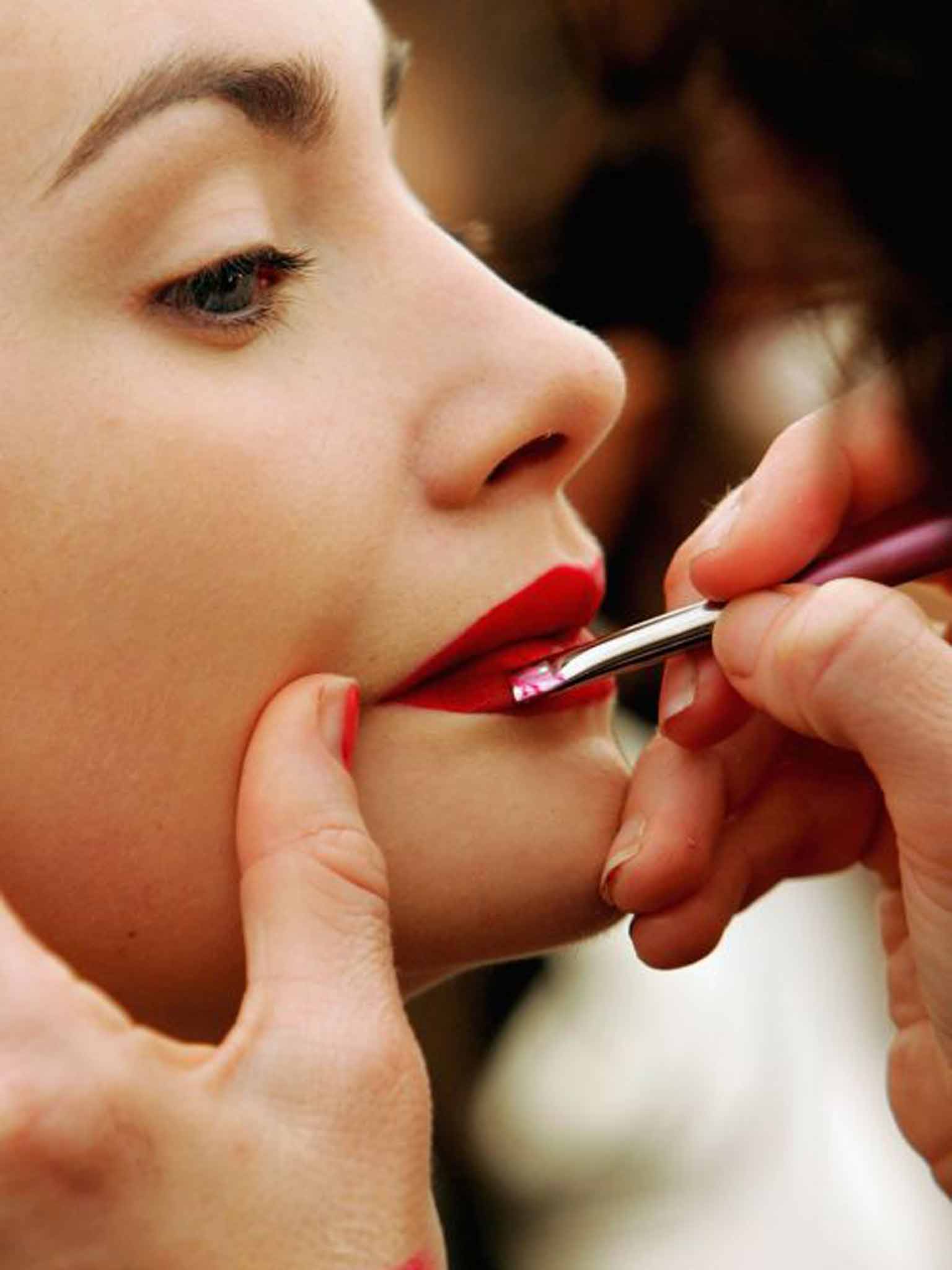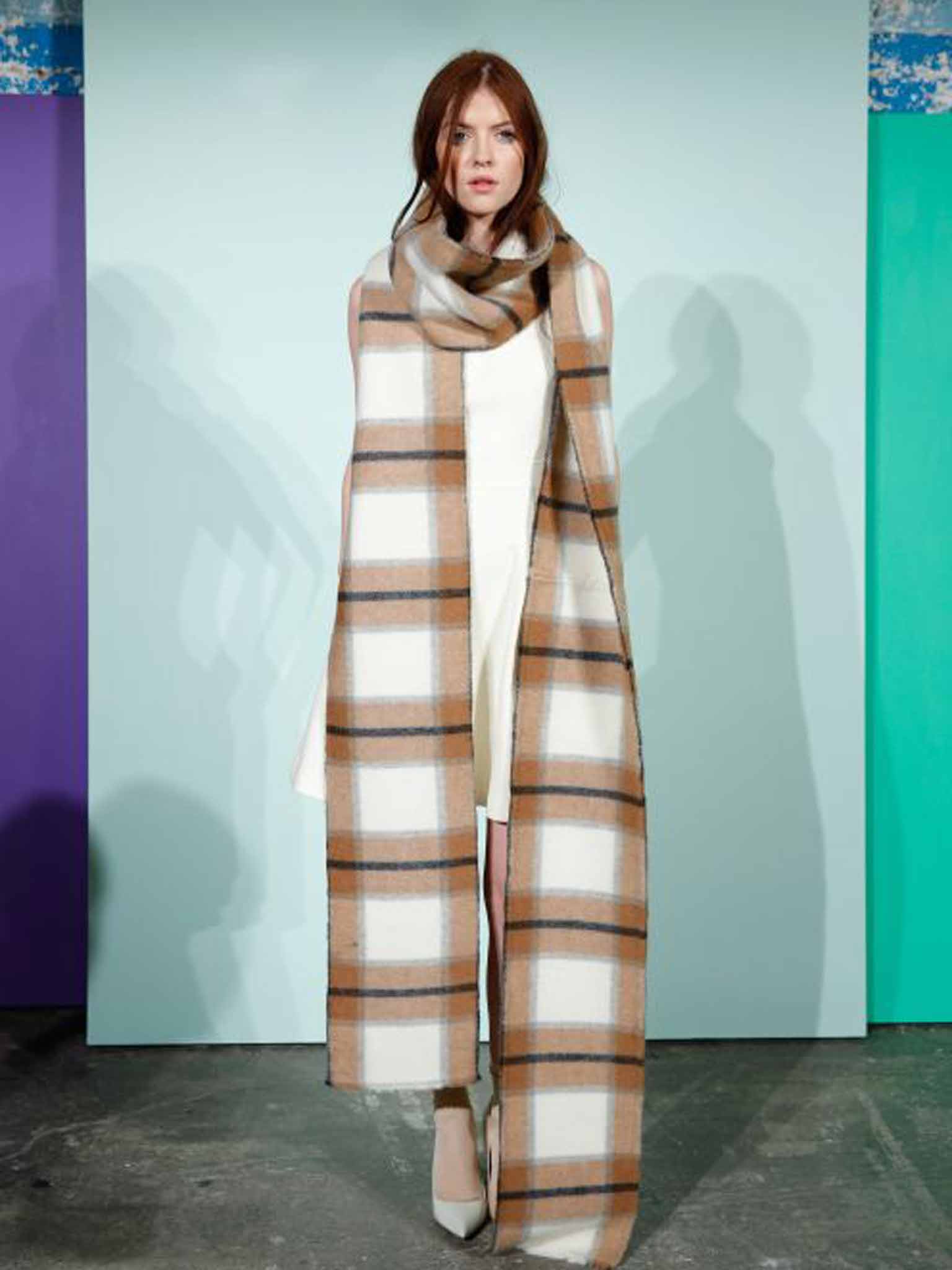How the fashion industry has injured women: From killer heels to 'long scarf syndrome'
You really could die for your clobber (like the sweatshop girls who made it). In a new book, Alison Matthews David looks at the dangers of dress past and present, and reveals a gendered agenda

During a routine experiment on 14 August 1996, Karen Wetterhahn, a 48-year-old chemistry professor at Dartmouth College who specialised in the study of toxic metal exposure, accidentally spilled a few drops of a mercury compound on her glove. Less than a year later, she was dead.
She believed that the latex gloves she was wearing would protect her and did not take them off immediately. Yet the "supertoxic" dimethyl mercury she was using soaked through her glove and entered her bloodstream in less than 15 seconds. Dr Wetterhahn did not have symptoms immediately, but after six months she started to have problems speaking, walking, hearing and seeing. Despite intensive medical treatment for mercury poisoning, she slipped into a five-month coma and then died on 8 June 1997. Her brain showed extensive damage, and tests on a strand of her hair showed it contained 4,200 times the amount of mercury normally found and 22 times the limit considered toxic.
Karen Wetterhahn's tragic death hinged on one key element: her protective glove failed to shield her hand from the poisonous organic mercury with which she worked. Although this accident happened in the rarified space of the scientific lab, all of us rely on clothing to protect us in our daily lives. Cloth shields us from the elements, comforts us, and preserves our modesty. It is our lifelong companion, from the blankets that swaddle us as babies to the shrouds that accompany some of us to the grave. However, clothing, which is supposed to shield our fragile, yielding flesh from danger, often fails spectacularly in this important task – and kills its wearers. Extreme styles have often been the most dangerous, yet the most banal everyday garments, including socks, shirts, skirts and even flannelette pyjamas, have harmed us.

In 19th-century Europe, clothing production industries thrived in large cities such as Paris, London and Manchester, and doctors were able to see the harmful effects of fashion first hand in homes, hospitals and urban workshops. Their observations were damning: fashion did not discriminate, harming men and women, young and old, producers and consumers, rich and poor. Increasing industrialisation and technological innovation in the garment industry was a mixed blessing. Male chemists, engineers and industrialists constantly developed and marketed new materials, harnessing science for the fashion industry. They brought formerly elite garments, accessories and colours within reach of the masses but introduced new hazards that damaged health in unexpected ways. More than one observer condemned the "progress" of "murderous luxury" but predictably blamed the female consumer's seemingly irrational desire for novelty in dress rather than male economic interests.
The medical professions have encouraged our cultural bias toward blaming women for health hazards caused by larger systemic problems. Nineteenth-century doctors and the press constantly broadcast the ways in which fashion harmed women with articles on "Fashionable suicide" and "Death in the workshop". Most middle-class commentators were more concerned with how women's dress harmed its wearers, and it was thought to cause a range of health problems, including damaged internal organs and, supposedly, even death from tightly laced boned corsets.
Although some accounts were greatly exaggerated, there is evidence of a fashion culture that was different from our own. Footwear is a good example: before the 1850s, "straights" that did not take the bilateral symmetry of human feet into account were the norm. Having no left and right shoes saved time for shoemakers, who only needed one last to make two shoes, but it deformed the feet. This practice is visible in the almost unbelievably narrow soles of many 19th-century men's and women's shoes, which show actual wear. To conform to the beauty ideal of a small, delicate foot, some women seem to have bound their toes with ligatures, almost like foot corsetry, to fit into their shoes.
Victorian doctors and dress historians focus on mechanical constraint, but other more lethal hazards were also making headlines in the 19th century. Somehow we seem to have forgotten many highly feared and often lethal dangers, including clothing that transmitted contagious disease, leached chemical toxins, caught workers in moving machinery and went up in flames. Newspapers and medical journals alike were filled with warnings of virulent infections spread by dirty laundry, "drop-dead gorgeous" green dresses tinted and tainted with arsenic, grisly strangulations and combustible crinolines that burnt their wearers alive. And although we may think these accidents are relegated to the past, a look at modern fashion hazards reveals that contemporary clothing can still be fraught with perils – particularly for women, whose more flamboyant fashions put them at greater risk than their male counterparts.
Accidents are gendered, and as domestic, urban and industrial environments changed, women's styles did not keep pace and, in some cases, even deliberately flaunted the dangers. Historically, the design of men's clothing and footwear has acknowledged their power and place in the public sphere and assured their mobility and safety. By contrast, women's shoes have privileged fashion over function. And unsurprisingly, stylish platforms and towering stilettos have long been implicated in a range of accidents.
The most famous faux pas in the modern fashion world was Naomi Campbell's 1993 catwalk fall from a pair of now iconic blue crocodile platforms by Vivienne Westwood. However, as this season's fashion weeks are proving, it's becoming something of an occupational hazard. If professional models trained to strut on catwalks can fall in this footwear, amateurs who adopt these styles as streetwear are in greater peril. Most spills caused by elevated footwear have resulted in twisted limbs, broken bones and contusions at worst – but in 1999, a fractured skull caused the death of a Japanese childcare worker who had fallen off high, cork-soled shoes several hours earlier.

When they were fashionable in the 1970s and 1990s, elevated platform shoes were blamed for car accidents. Although men wore high platforms in the 1970s, one gender-biased 1974 study targeted women drivers, putting young female students to the test. They had to perform emergency braking manoeuvres on a laboratory automobile simulator. Criteria for participation "included ownership of platform shoes and at least two months' experience driving in them". The participants drove for 40-minute sessions in platform and then in so-called normal shoes. The platform shoes universally slowed braking speeds, and at a highway speed of 70mph, it took an extra 10ft on average to come to a full stop wearing even a familiar pair of shoes.
When platforms such as those 6in-high black and red Buffalo boots worn onstage by Ginger Spice reappeared in the mid-1990s, they were widely adopted by fans. Yet some police considered them a threat to safe driving equivalent to drinking alcohol. In 1999, a 25-year-old Tokyo woman was driving home from a shopping trip with her friend. Her eight-inch-high boots stopped her from braking, and she crashed into a concrete pole, killing her friend in the passenger seat. While traditional geta sandals and slippers were already legally banned for driving, police in Osaka said that they would now also ban Atsuzoko butsu, or thick-heeled boots.
As platform accidents suggest, the imperatives of fashion and modern urban contexts do not always mix. Yet should we blame the person wearing fashionable garments for causing accidents to themselves or others, or blame dangerous trends and the economies driving them? The 1970s saw the revival of many 1920s fashions, including long scarves such as the charmingly eccentric knitwear sported by Tom Baker as Doctor Who. When mere mortals copied the style, it could prove fatal.
In 1971, a young American mother in her early twenties was "hauled out of her seat while riding a ski lift when her scarf wrapped around an oncoming chair". (An article in The Journal of American Medicine dubbed cases such as hers "long scarf syndrome".) Others were luckier: in the same year, a 10-year-old girl whose scarf caught in a tow rope, an 11-year-old boy whose scarf became entangled in his snowmobile engine, and a teenager who was bending down to look at a motorcycle all escaped with their lives, though they suffered severe facial lacerations and bruises. The doctors concluded that such accidents had a 45 per cent death rate and that new "vogues, fads, and fashions frequently produce unsuspected inherent dangers".
One such was boho chic, revived in 2004 by the actress Sienna Miller. This look included long white peasant or gypsy skirts – mass-marketed in an endless variety of colours and styles but always with several tiers of flounces. Pretty as they were, these skirts represented a serious fire hazard for some of the women who wore them. In the autumn of 2005, the Northamptonshire Trading Standards Association issued a warning about the high risk after a nine-year-old girl suffered serious burns. In the same year, the Burns Unit of Mersey Hospital published an article called "The flaming gypsy skirt injury". In 2005, the specialist unit treated six burn cases specifically caused by the gypsy skirt: two accidents occurred while women were distracted by talking on the phone; dancing ignited one skirt, and another caught fire from decorative candles placed on the floor.
When we consider the number of these accidents caused by such floating garments, worn in contemporary domestic environments in which danger might come from the odd tea light and is treatable by modern medicine, it becomes easier to imagine how much more lethal historical forms of dress could be for those who wore them in spaces heated and lit by highly flammable gas, wood, coal and candles.
If an accident occurs now, the police, childcare professionals, and emergency room doctors jump in to warn and protect the public. Government bodies often regulate or ban dangerous clothing items before accidents can happen. For example, the European Commission's rapid alert system for non-food dangerous products (Rapex) publishes weekly alerts that include hazardous clothing, cosmetics and even tattoo inks and bans them if they present "serious risks".
In 2013, more than 200 girls' bikinis and hoodies with laces or drawstrings that presented risks for strangulation or injury were banned and taken off the market. But historically, attitudes toward accidents were radically different. Before the 19th century, fashion presented more of a moral than a medical risk. Exaggerated silhouettes and garments were worn only by a small elite and caricatured for public entertainment and supposedly for moral edification.
An 18th-century print called "L'incendie des Coeffures", or "The Headdress Blaze", satirizes the hazards of high wigs. It shows a couple about to sit down for some refreshment at the Café Royal D'Alexandre, a Parisian establishment where large glass windows allowed rich, fashionable customers to be seen by passers-by. While the man politely offers his companion a seat, the candles in the chandelier have set the woman's wig on fire. Terrified café employees have set up a stepladder and scramble to extinguish the flames. The unsympathetic caption reads: "Why throw water? In this adventure I would let the foolish hairstyle burn." Real wigs would not have been high enough to catch fire, although the starch that powdered and whitened them would have made them highly flammable. Even though this print presents us with an imaginary scenario, in the decades that followed, women's dress did become a lethal fire hazard, and many perished when their cotton dresses, wide crinoline skirts and hair combs were set ablaze.
Or else they chose a slower, toxic death – and we still knowingly use poisons to make ourselves more beautiful. (Botox is derived from Clostridium botulinum, the most acutely lethal toxin known.) We may think that historic problems such as lead in Elizabethan cosmetics are safely relegated to the past, but despite constantly changing fashions in make-up, lead can still be found in many of our lipsticks today.
This fact is something of a scandal. As far back as the 1860s, it was known that lead absorbed through the skin could cause a condition called radial nerve palsy. But in 1875, an American face powder, Tetlow's Swan Down, was launched and marketed as "harmless". Henry Tetlow, a British immigrant to Philadelphia, started a highly successful cosmetics and perfumery company. His brand was based on the fact that he ostensibly discovered cheap, whitening zinc oxide powder, the same ingredient used in sunblocks today, to replace toxic products used in earlier cosmetics. Women with modest budgets could now afford rouge and powder, and they made Tetlow's fortune.
However, when I purchased an untouched box of Swan Down from an antiques dealer and had the contents tested at Ryerson University in Toronto, the results were damning: the powder did indeed contain zinc, but it also contained a significant amount of lead. Swan Down's promise was that it would stay "forever" on the face; in fact, it took up a permanent home in the bones and teeth of its purchasers.
And lead in pigments is still a problem. Because it is legally considered a contaminant and not an ingredient, lead is never listed on lipstick labels. So what happens if we accidentally eat some of our lipstick off our lips (and the skin on our lips is very thin, which allows toxins to be quickly absorbed into our bodies)? Even though no level of lead is considered safe, the US Food and Drug Association (FDA) has deemed that there are no safety concerns when lipstick is applied topically "as intended".
A 2011 study by the FDA found lead in all 400 of the lipsticks they tested. In June 2013, I went on a hunt for the colours with the highest lead content in several outlets and found two of the top seven, L'Oreal's Colour Riche Volcanic No 410 and Tickled Pink No 165.
Even though the amounts were miniscule and within FDA limits, I would never apply them to my own lips. However, I can understand their appeal. Volcanic comes in a shiny gold tube, smells sweet and probably creates a rich, smooth, bright orange that was a trendy and even avant-garde colour on the Prada, Marni and Marc by Marc Jacob runways in autumn 2010. I had the two lipsticks tested again, and a reformulated Volcanic had reduced lead content from more than seven to only one part per million, but Tickled Pink still contained the same amount as it had three years earlier.
It is still not clear exactly how much lipstick we actually ingest, if any; similarly, whether these ingredients may or may not cause harm to lipstick wearers. But I do condemn the lack of regulation that keeps lead from lists of cosmetic ingredients. I believe that we continue to use these products both out of ignorance and because they are fragrant, seductive, glamorous and well-marketed. And any hazard is gendered. National health and safety legislation in many countries typically distinguishes between less stringently regulated products used for "adornment", including cosmetics and hair dye, and those used for "personal care", such as shampoos and deodorant. This gender discrimination ignores the fact that many women are socially and professionally required to wear cosmetics on the job.
Though historical sartorial transgressions are great, we need more social and scientific research into the hazards that still harm those who make and wear fashion today. To die for? It's really not worth it.
This is an edited extract from 'Fashion Victims: The Dangers of Dress Past and Present' by Alison Matthews David (Bloomsbury), published on Thursday.
Join our commenting forum
Join thought-provoking conversations, follow other Independent readers and see their replies
Comments